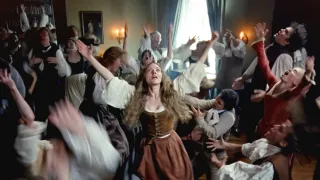January 24, 2019
BGMC Spring Concert Will Give Voice to Black Lives Tragically Lost
READ TIME: 4 MIN.
The Boston Gay Men's Chorus (BGMC) is pleased to announce its spring concert "Raise You Up," which will explore themes of racial injustice, human resilience, and the power of love and community in creating a more just world. The concert will feature the stirring piece "Seven Last Words of the Unarmed," which sets to music the final words of seven black teenagers and adults who died at the hands of police or authority figures, and special guest Todrick Hall, the multi-talented star of Broadway, television, and YouTube. Performances take place Saturday, March 16 at 8 p.m. and Sunday, March 17, 2019 at 3 p.m. at New England Conservatory's Jordan Hall in Boston.
The first half of the show features Atlanta-based composer Joel Thompson's "Seven Last Words of the Unarmed," which uses the text structure of Joseph Haydn's "Seven Last Words of Christ," to give voice to the final words of Michael Brown, Amadou Diallo, Kenneth Chamberlain, John Crawford, Eric Garner, Oscar Grant, and Trayvon Martin, inviting reflection on their humanity, their value, and the tragedy of lives lost too soon.
"As a chorus with a social justice mission, we're excited to perform this beautiful and deeply moving piece of music, especially after our visit to the Apartheid Museum during our South Africa Tour last June, where our members were shaken by the parallels of South African apartheid to our own country's history of racism and our present struggles, as well," said BGMC Music Director Reuben M. Reynolds III. "Racism affects us all and the only way out is if we all accept responsibility and be a part of the solution. Music helps to create empathy and we hope our audience will reflect on the issue of racial injustice as well as our shared humanity and the ways we can deal with racism and move forward."
In writing the multi-movement choral work, Thompson was inspired by the artwork of Iranian-American artist Shirin Barghi's illustrations of the last words of these and other unarmed black men who were killed in similar circumstances. The seven-minute piece was premiered by the University of Michigan Men's Glee Club, the second oldest collegiate choir in U.S., in 2015.
In the build up to "Seven Last Words of the Unarmed," the chorus will perform the lushly romantic "Never Get Lost/Take Me to the World," by Marc Blitzstein and Stephen Sondheim that promises listeners "We shall see the world come true." Next comes "We Sang Our Songs," by William Grant Still, the first well known African American classical composer, which is about one generation fighting for freedom so the next can benefit.
BGMC Principal Accompanist and Assistant Music Director Chad Weirick has arranged the three spirituals "If I Got My Ticket," "Deep River," and "Go Down Moses" for five strings. The spirituals will be followed by Rollo Dilworth's "Harriet Tubman" and Joan Szymko's "It Takes a Village."
BGMC's staging of the "Seven Last Words of the Unarmed" will conclude with a performance of "Glory" from the film "Selma." The Academy Award-winning song of resilience and triumph over racial injustice has effectively become a companion piece to Thompson's work.
The second act of "Raise You Up" will feature solo and joint performances by Todrick Hall. The entertainer, director and choreographer is best known for his star-making turn on "American Idol," his inventive YouTube presence, and his starring Broadway roles as Lola in "Kinky Boots" and Billy Flynn in "Chicago." Hall has also released several albums and regularly appears as a judge on the Emmy-winning drag queen competition "RuPaul's Drag Race."
Hall and BGMC will perform selections from "Kinky Boots," and celebratory, affirming pop anthems made famous by the likes of Whitney Houston and Christina Aguilera.
"Todrick Hall is a supremely talented and exciting performer and we can't wait to share the stage with him," said BGMC Executive Director Craig Coogan. "'Raise You Up' will be a challenging and enlightening concert but it will also demonstrate how music can bring us together, lift us up, and inspire our better angels."
About the Boston Gay Men's Chorus
Boston Gay Men's Chorus creates musical experiences to inspire change, build community and celebrate difference. The BGMC is one of New England's largest and most successful community-based choruses. Founded in 1982, the 200-voice ensemble is celebrated for its outstanding musicianship, creative programming, and groundbreaking community outreach. Under the dynamic leadership of Music Director Reuben M. Reynolds III, the BGMC sings a wide spectrum of classical and popular music and creates social change by providing a positive, affirming image of the gay and lesbian community. The Chorus is heard live by more than 10,000 people each season and thousands more through recording, television and internet broadcasts. CBS-WBZ named The Boston Gay Men's Chorus one of the "top five" choruses in the city of Boston. BGMC are Cultural Ambassadors - being the first LGBT chorus to perform in Poland in 2005, the Middle East in 2015 and in South Africa in June 2018.






